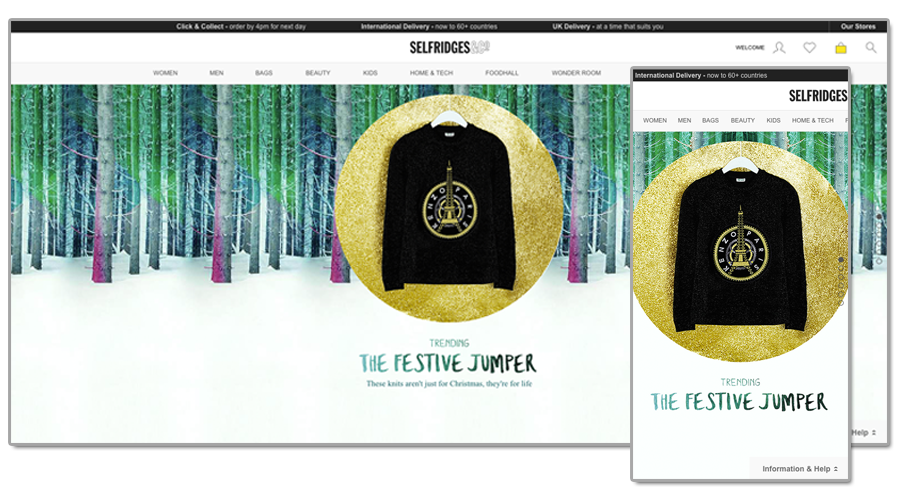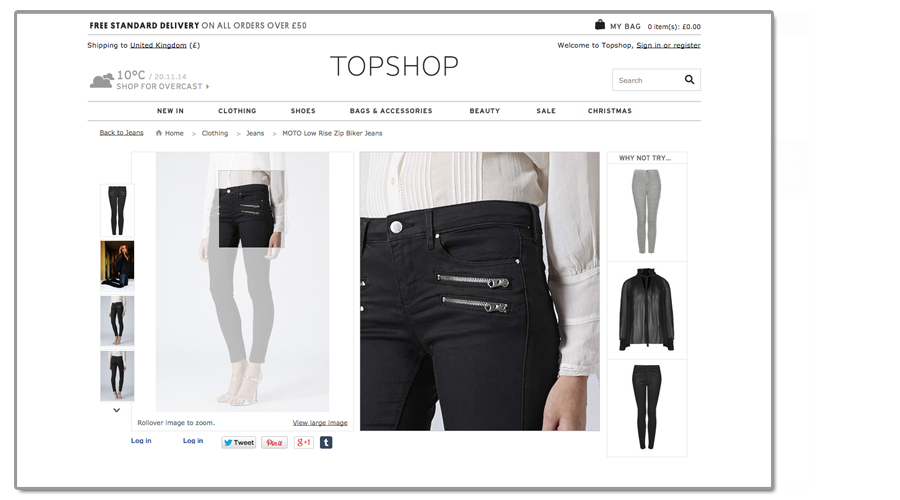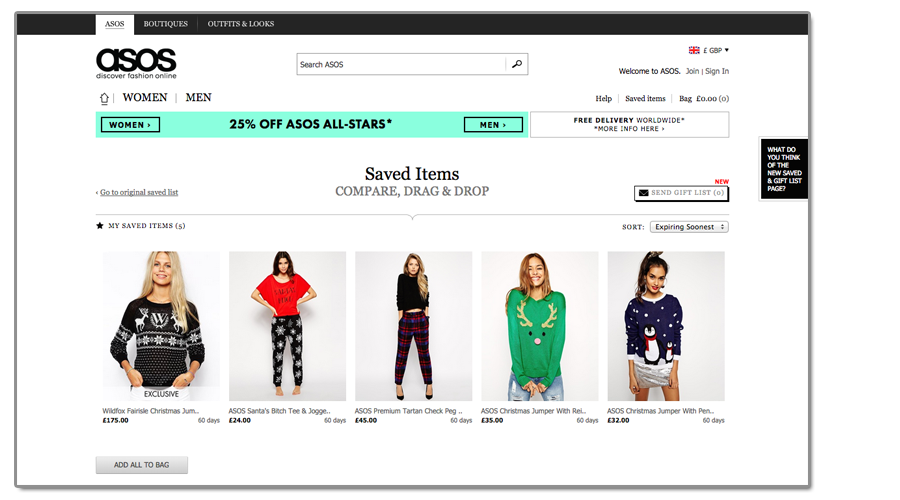The majority of visitors to fashion eCommerce websites are women in their twenties.
We’re busy women, juggling careers, young families and social activities – we’re not interested in wasting time on busy high streets and we certainly don’t have the patience to navigate around an ill-developed online shopping portal.
This list provides an honest insight into exactly what we want when we land on your eCommerce website.
1. Responsive design
Selfridges recently revealed that 60%1 of traffic to its website is from mobile and tablet devices. Subsequently, the company invested £40 million into a revamp that adapts to every screen size and is completely touch-responsive.
A responsive layout is now something that we expect as shoppers. If we see Cara Delevingne donning thigh-high boots on a billboard outside Old Street station, we want to Google some on our iPad there and then. If a Facebook invite to our best bud’s birthday bash pops up on our mobile app, we want to hunt down an outfit to wear to the party with a swipe of our thumb.
There’s really no excuse for retailers. One responsive design can be accessed from anywhere in the world on any type of device – it assures us that you’re a modern company – and it’ll probably help you reach those sales targets.
eFashion Fact: Like in real life, men want to get in and out of a shop as quickly as possible. Women will browse your website for longer and click on more products – and they’re most likely to proceed to checkout on mobile.
2. Free delivery
eFashion Fact: 71%2 of women actively look for the best price, compared to just 57% of men.
ASOS led the fashion pack by offering free delivery and no-quibbles returns. Customers may buy two sizes of the same t-shirt with every intention to return one, but this intrinsic part of ASOS’s eCommerce model is a major pulling point, and nobody can argue with the world’s most visited3 fashion website which commands a revenue of £800 million.
Even if you can’t offer free delivery, at least make your charges clear from the outset because 50% of customers will abandon their basket if an unexpected delivery fee is lumped on without warning. As a pointer, we generally look to the header for information about delivery fees.
Whilst we may be more likely to part with the cash for rare finds from independent retailers, we’re less inclined to pay a hefty delivery charge with a large retailer such as H&M, considering there are branches on every major high street.
3. Quality photography and video
Poorly lit, badly cropped or over photoshopped? Your bounce rates are going to spike.
Fashion is visual. We want to see those jeans from every angle and we want to be able to zoom in on the finer details too.
Videos are a plus as well. Online shopping removes the sense of touch from the shopping experience but a video of the garment on a real-life model can show us how the fabric moves and fits – if we like what we see, we’re more likely to put it in our basket.
eFashion Fact: Good imagery travels far. On the female dominated social network Pinterest, 18%4 of content engagement within retail and fashion is driven by brands, the remaining 82% is initiated by users themselves.
4. Quick view pop-ups
eFashion Fact: A business loses around 25%5 of its online visitors if a website takes longer than 4 seconds to load. The average eCommerce site takes a risky 8.56 seconds to fire up.
A quick view option, wherein a box with more pictures and details about a garment pops up without having to load a new landing page is becoming more common. If you have a large volume of stock, this will be particularly well received because people can browse more items in the same amount of time, which increases your odds for a sale.
Although alternative views are the aim with this one, it’s preferable not to forget the product details here. The aim to to provide the information needed for the user to add that item to their bag without visiting the product page.
5. A ‘save for later’ button
The ‘save for later’ feature is something that is cropping up more often and now appears on some of the most popular eCommerce websites, with retailers such as ASOS holding items for up to 60 days.
By using our cookies, we can save things whilst we’re on-the-go and come back to them later – whether that’s payday or when we emerge from the Northern line.
eFashion Fact: The majority of all online purchases are made from home (87% for men and 82% for women) – so make it easy for us to pick up where we left off during our lunch break at the office.
6. Payment card memory
Storing our debit or credit card details breaks down barriers at the checkout.
Whilst we’re not that keen on giving up our details during our first purchase, once you’ve proved you can deliver us what we want and on time, we’ll be less apprehensive about doing so.
eFashion Fact: Women are less likely to forgive a bad shopping experience than men are. However, impress from the get-go and you’ll see that a woman’s brand loyalty lasts longer and spend will be more frequent.
1 The Drum, 2014. Selfridges invest £40m to ‘future-proof’ digital offering. [Online] Available at: http://www.thedrum.com/news/2014/10/01/selfridges-invests-40m-future-proof-digital-offering.
2 Small Business Trends, 2014. Online Male Shoppers Are From Mars, Women Are From Venus. [Online] Available at: http://smallbiztrends.com/2013/08/male-vs-female-shopping-behavior-survey.html.
3 Flashes & Flames, 2014. [Online] Available at: http://www.flashesandflames.com/2014/03/why-asos-is-an-e-commerce-warning-for-magazines/.
4 Kissmetrics, 2014. 15 hazards that will cripple your e-commerce site’s load time. [Online] Available at: https://blog.kissmetrics.com/ecommerce-load-time-hazards/.
5 Digiday, 2014. 15 Stats Retailers Should Know About Pintrest [Online] Available at: http://digiday.com/brands/15-stats-retailers-should-know-about-pinterest/.
All information sources accessed on 20th November 2014.



